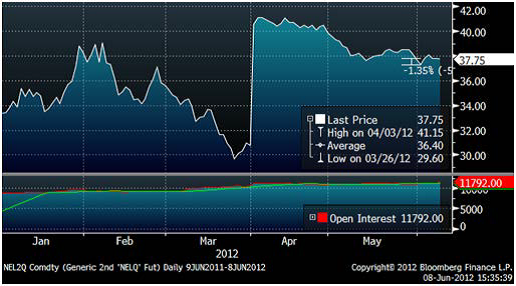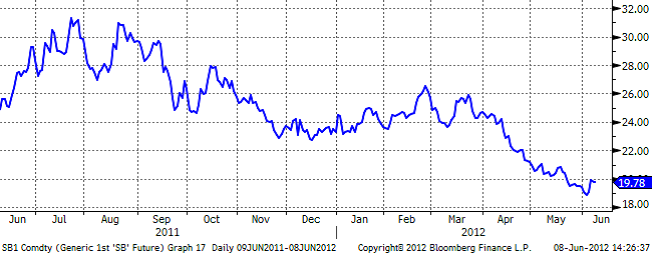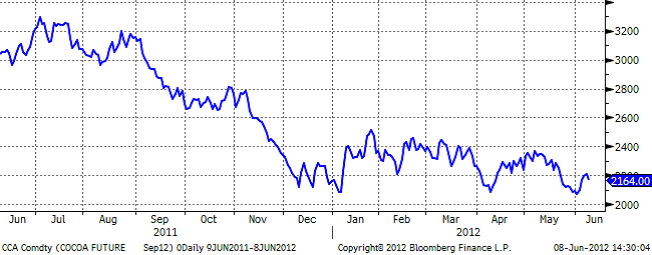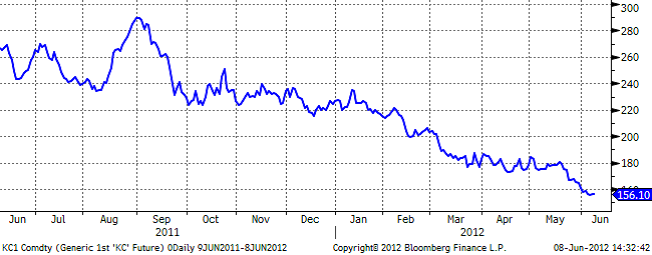Analys
SHB Råvarubrevet 6 juni 2012
 Råvaror Allmänt
Råvaror Allmänt
- Energi: Neutral
- Basmetaller: Neutral
- Ädelmetaller: Negativ
- Livsmedel: Neutral
En händelserik vecka ligger bakom oss och en händelserik helg ligger framför oss. Kina släpper majdata för inflation, industriproduktion och handelsdata, vilken inkluderar import av olika råvaror.
Under veckan sänkte Kina räntan för första gången sedan 2008. Det gav marknaden farhågor om att helgens data kommer visa på en allt sämre kinesisk konjunktur som behöver ytterligare stimulanser för att komma på fötter. Räntesänkningen indikerar att de tidigare sänkningarna i reservkraven inte gett önskad effekt och att efterfrågan på pengar kanske är ett större problem än utbudet på pengar.
Chefen för amerikanska centralbanken, Bernanke svävade på målet kring framtida amerikanska stimulanser vilket fick marknaden att vekna och guldet såldes av. Under veckan fick också Spanien sänkt kreditbetyg och sex tyska banker fick en släng av samma slev.
Bottenfiske brukar löna sig men före vi rekommenderar köp på bred front i råvaror vill vi se tydliga tecken på att kinas konjunktur har bottnat ut och att den fundamentala råvarumarknaden får stöd av att lagercykeln i Kina ska fyllas på. I det korta perspektivet är det fortfarande investerares sentiment som styr marknaden. Det gör den nyckfull och svår.
Energi (neutral)
Elmarknaden handlas i stort sett oförändrat över veckan där våta väderprognoser och låga spotpriser fortsatt tynger utvecklingen. Inga rörelser inom bränslekomplexet som påverkar elmarknaden i någon större utsträckning, fossila bränslen och energikol i synnerhet är under press och med en förväntat stark utveckling på dollarn har vi svårt att se hur kolet ska stiga på kort sikt. Utsläppsrätter och kontinentala marknader ger inte heller de någon riktning utan fokus förblir på väderprognoserna. De senaste körningarna pekar på ett scenario med nederbörd om närmare 7-8 TWh vilket i så fall skulle förbättra energibalansen med ytterligare 3 TWh.
Kvartalet Q4 2012 som från och med denna vecka är underliggande för SHB Power Index handlas på 37.65 euro mot slutet av veckan vilket får ses som förhållandevis lågt om man tänker på att kontraktet omfattar ett antal vinterdagar där det alltid finns risk för kyla och bortfall av kärnkraftskapacitet som kan dra upp spotnivåerna. Vi har dock svårt att se hur kontraktet skall stiga på kort sikt när de flesta faktorer pekar fortsatt ned och marknaden fastnat i en range. Med andra ord kan det vara klart intressant för den som kanske vill prissäkra de lite längre kontrakt men mindre intressant för den som vill gå in i ett hävstångscertifikat just nu eftersom man sannolikt behöver sitta på det en längre tid innan vi lyckas bryta ur dessa nivåer.
Basmetaller (neutral)
Det har varit en händelserik vecka för basmetallerna som startade veckan med två dagar där LME höll stängt. Sedan fick vi se uppgångar efter Kinas räntesänkning som sedan raderades efter Bernankes tal. Aluminium och koppar har haft samma rörelsemönster som övriga metaller under veckan med både upp och nedgångar men stänger veckan i princip oförändrad. Aluminium lagret i Shanghai steg för första gången på 5 veckor med 915 ton till 320 495 ton. Samtidigt föll lagret på LME med 11 175 ton till 4,86 miljoner ton. Fallande lager på LME ger stöd till priset som pressas i en marknad som denna. Värt att notera är att nickel går mot strömmen och steg med nästan 1,5 % under fredagens handel. Nickel, 3-månaders på LME handlas i skrivande stund på 16840 USD/ton vilket är 4% högre än öppningen i onsdags. Priset får stöd av bland annat fallande lager på LME som på tre dagar sjönk med 2,3 %.
Ädelmetaller (Negativ)
Upp som en sol, ner som en pannkaka
Förra fredagen steg guldpriset med drygt fem procent efter usla amerikanska jobbmarknadssiffror, och vi fick uppleva ett kort ögonblick av guldets klassiska ”säker hamn”-funktion. En händelselös vecka har därefter gjort att ädelmetallerna legat still större delen av veckan, fram till att USA:s centralbankschef Ben Bernanke talade inför kongressens finansutskott. Avsaknad av tydlighet gjorde att marknaden sålde guld igen, och större delen av förra fredagens uppgång är nu utraderad.
Vi hoppas att nästa vecka bjuder på mer spänning på guldfronten än den vecka som nu gått, och vi behåller vår negativa vy på sektorn.
Softs och livsmedel
50 % risk för El Nino senare i år enligt rapporter från US Weather Center. El Nino är ett ett av de mest kraftfulla återkommande klimat och hydrologiska fenomen i Stilla Havet, och innebär i korta drag förändringar i tryckförhållandena i atmosfären, vilket leder till att passadvindarna försvagas och ändrar riktning vilket påverkar havsströmmarna. Normalt är ytvattnet i Stilla Havet ca 8 grader kallare utanför Ecuadors och Perus kuster än vad det är utanför Indonesien och Australien, El Nino skulle vända på dessa förhållanden. El Nino skulle medföra torka i sydöstra Asien och Australien samt översvämningar i Sydamerika. Senast El Nino orsakade stor skada var 1998, fler än 2000 personer omkom, och skadorna på skördar och gruvor var omfattande. El Nino påverkar även orkansäsongen i Atlantområdet (färre till antalet) och meteorologer har redan estimerat färre kraftiga orkaner (jämfört med året innan) för säsongen som startade 1 juni och pågår till sista november. National Oceanic and Atmospheric Administration förutspår 9-15 tropiska stormar under årets säsong varav 4-8 kan utvecklas till orkaner och av dessa 1-3 till kraftiga orkaner (kategoriserat 3:or på Saffir-Simpson
skalan).
Men, atlantområdet har redan namngivit två orkaner innan säsongen påbörjats, Alberto och Beryl. Alberto var den tidigaste Atlantstormen sedan 2003.
Vete
Rapporter om torrt väder, främst i USA och Ryssland, har drivit upp priserna på vete under veckan. Novemberkontraktet på matif har stigit med 1,7 % och på Chicagobörsen har decemberkontraktet 2012 stigit med 1,2 %. Det varma och torra vädret ser ut att fortsätta i USA, dock med någon lätt nederbörd som kan ses som positivt för vetet. Torka med fortsatt höga temperaturer fortsätter även i Ryssland, även om det ser ut att komma en del regn behövs mer nederbörd. Skörden i USA är igång och ligger långt fram jämfört med normalt, vilket fick priset att falla tillbaka något under fredagen. Situationen just nu gör marknaden svårbedömd och vi håller en neutral vy.
Majs
Terminspriset på majs har likt vete stigit under veckan, upp dryga 5 % för det närmaste kontraktet. Vädersituationen för de majsproducerande regionerna ser även de torra ut men prognoser visar på regn till nästa vecka i flertalet regioner vilket talar för en bättre skörd. Vi ser därför fallande priser under fredagen.
Sojabönor
Sojapriserna i Chicago har även de stigit i veckan, novemberterminen har stigit med 5,3 %. Idag rapporterar USDA (U.S. Department of Agriculture) att USA sålt 410 000 ton sojabönor till Kina och ytterligare 120 000 ton till Egypten.
Socker
Regn i Brasilien, handeln inför Ramadan och en svagare valuta (Real) har fått priset på socker att stiga under veckan. En kallfront passerar Brasilien och har medfört kraftig nederbörd vilket dels har påverkat skörden men även lastning av råvaran. Flertalet sockerproducenter har stoppat skörden de senaste dagarna och mängden socker som inväntar export i landets hamnar ökade med 37 % under veckan som gick. Totalt 2 197 millioner ton socker finns lagrat i hamnarna av vilket ca 20 % (430 250 ton) har Kina som destination. Hur mycket den senaste tidens regn påverkar volymen på Brasiliens totala skörd är fortfarande oklart.
Kakao
Afrika stod för nästan 75 % av världens kakaoproduktion förra året. Ghana och Elfenbenskusten producerade bägge rekordskördar 2011/12, vilket kan komma att ändras på i framtiden. Nanga Coulibaly, Alliance of Cocoa Producing countries generalsekreterare uttalade sig i veckan om utsikterna för Afrikas framtid som kakaoproducent. Ett globalt väderskifte skapar på sikt mer torka i Afrika vilket inte är gynnsamt för kakaoproduktionen. De regnperioder man tidigare kunnat räkna med i området är inte längre lika självklara, och flertalet afrikanska producenter rapporterar ovanligt långa perioder av torka i år, vilket får International Cocoa Organisation att rapportera 12 % lägre produktion än säsongen 2010/11. Stora delar av Afrikas kakaoträd behöver bytas ut p.g.a. ålder, d.v.s . oberoende av ändrade väderförhållanden, träden producerar inte tillräckligt eller är mer mottagliga för diverse sjukdomar som kan påverka totala skörden. Detta innebär en merkostnad för producenterna vilka även fått sina inkomster reducerade till följd av de rådande låga priserna. Låga inkomster i landet har fått flertalet unga att söka jobb i städerna och underskottet på unga kakaoproducenter är stort. Flere Afrikanska länder har insett problematiken i detta och har påbörjat åtgärdsplanering.
Kaffe
Världens största kaffeproducent Brasiliens valuta Real fortsätter att vara svag gentemot dollarn vilket har genererat en högre exportvolym och större utbud på den internationella marknaden. Priset på kaffe fortsätter på låga nivåer och Arabica terminerna har fallit tillbaka med över 30 % i år. Globala kaffeproduktionen har reviderats upp för säsongen som påbörjats i oktober. Globala kaffekonsumtionen steg 1,7 % under 2011 vilket är något under snittet för de senaste 12 åren, enligt International Coffee Organization. All Japan Coffee Association rapporterar något lägre lagersiffror, april ner 2,4 % jämfört med mars och med andra ord andra månaden i följd som japanska kaffelagren minskar.
Handelsbankens Råvaruindex
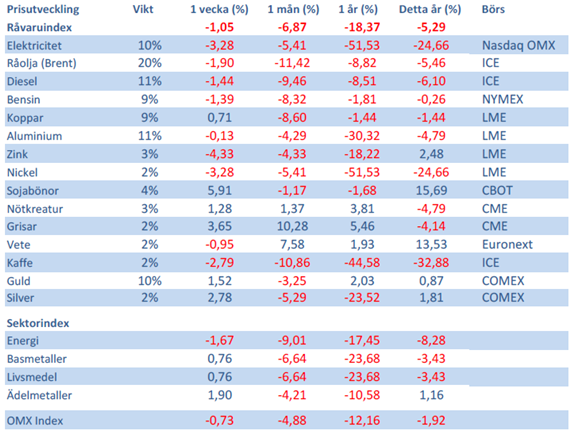
Handelsbankens råvaruindex består av de underliggande indexen för respektive råvara. Vikterna är bestämda till hälften från värdet av global produktion och till hälften från likviditeten i terminskontrakten.
[box]SHB Råvarubrevet är producerat av Handelsbanken och publiceras i samarbete och med tillstånd på Råvarumarknaden.se[/box]
Ansvarsbegränsning
Detta material är producerat av Svenska Handelsbanken AB (publ) i fortsättningen kallad Handelsbanken. De som arbetar med innehållet är inte analytiker och materialet är inte oberoende investeringsanalys. Innehållet är uteslutande avsett för kunder i Sverige. Syftet är att ge en allmän information till Handelsbankens kunder och utgör inte ett personligt investeringsråd eller en personlig rekommendation. Informationen ska inte ensamt utgöra underlag för investeringsbeslut. Kunder bör inhämta råd från sina rådgivare och basera sina investeringsbeslut utifrån egen erfarenhet.
Informationen i materialet kan ändras och också avvika från de åsikter som uttrycks i oberoende investeringsanalyser från Handelsbanken. Informationen grundar sig på allmänt tillgänglig information och är hämtad från källor som bedöms som tillförlitliga, men riktigheten kan inte garanteras och informationen kan vara ofullständig eller nedkortad. Ingen del av förslaget får reproduceras eller distribueras till någon annan person utan att Handelsbanken dessförinnan lämnat sitt skriftliga medgivande. Handelsbanken ansvarar inte för att materialet används på ett sätt som strider mot förbudet mot vidarebefordran eller offentliggörs i strid med bankens regler.
Analys
Tightening fundamentals – bullish inventories from DOE

The latest weekly report from the US DOE showed a substantial drawdown across key petroleum categories, adding more upside potential to the fundamental picture.

Commercial crude inventories (excl. SPR) fell by 5.8 million barrels, bringing total inventories down to 415.1 million barrels. Now sitting 11% below the five-year seasonal norm and placed in the lowest 2015-2022 range (see picture below).
Product inventories also tightened further last week. Gasoline inventories declined by 2.1 million barrels, with reductions seen in both finished gasoline and blending components. Current gasoline levels are about 3% below the five-year average for this time of year.
Among products, the most notable move came in diesel, where inventories dropped by almost 4.1 million barrels, deepening the deficit to around 20% below seasonal norms – continuing to underscore the persistent supply tightness in diesel markets.
The only area of inventory growth was in propane/propylene, which posted a significant 5.1-million-barrel build and now stands 9% above the five-year average.
Total commercial petroleum inventories (crude plus refined products) declined by 4.2 million barrels on the week, reinforcing the overall tightening of US crude and products.


Analys
Bombs to ”ceasefire” in hours – Brent below $70

A classic case of “buy the rumor, sell the news” played out in oil markets, as Brent crude has dropped sharply – down nearly USD 10 per barrel since yesterday evening – following Iran’s retaliatory strike on a U.S. air base in Qatar. The immediate reaction was: “That was it?” The strike followed a carefully calibrated, non-escalatory playbook, avoiding direct threats to energy infrastructure or disruption of shipping through the Strait of Hormuz – thus calming worst-case fears.

After Monday morning’s sharp spike to USD 81.4 per barrel, triggered by the U.S. bombing of Iranian nuclear facilities, oil prices drifted sideways in anticipation of a potential Iranian response. That response came with advance warning and caused limited physical damage. Early this morning, both the U.S. President and Iranian state media announced a ceasefire, effectively placing a lid on the immediate conflict risk – at least for now.
As a result, Brent crude has now fallen by a total of USD 12 from Monday’s peak, currently trading around USD 69 per barrel.
Looking beyond geopolitics, the market will now shift its focus to the upcoming OPEC+ meeting in early July. Saudi Arabia’s decision to increase output earlier this year – despite falling prices – has drawn renewed attention considering recent developments. Some suggest this was a response to U.S. pressure to offset potential Iranian supply losses.
However, consensus is that the move was driven more by internal OPEC+ dynamics. After years of curbing production to support prices, Riyadh had grown frustrated with quota-busting by several members (notably Kazakhstan). With Saudi Arabia cutting up to 2 million barrels per day – roughly 2% of global supply – returns were diminishing, and the risk of losing market share was rising. The production increase is widely seen as an effort to reassert leadership and restore discipline within the group.
That said, the FT recently stated that, the Saudis remain wary of past missteps. In 2018, Riyadh ramped up output at Trump’s request ahead of Iran sanctions, only to see prices collapse when the U.S. granted broad waivers – triggering oversupply. Officials have reportedly made it clear they don’t intend to repeat that mistake.
The recent visit by President Trump to Saudi Arabia, which included agreements on AI, defense, and nuclear cooperation, suggests a broader strategic alignment. This has fueled speculation about a quiet “pump-for-politics” deal behind recent production moves.
Looking ahead, oil prices have now retraced the entire rally sparked by the June 13 Israel–Iran escalation. This retreat provides more political and policy space for both the U.S. and Saudi Arabia. Specifically, it makes it easier for Riyadh to scale back its three recent production hikes of 411,000 barrels each, potentially returning to more moderate increases of 137,000 barrels for August and September.
In short: with no major loss of Iranian supply to the market, OPEC+ – led by Saudi Arabia – no longer needs to compensate for a disruption that hasn’t materialized, especially not to please the U.S. at the cost of its own market strategy. As the Saudis themselves have signaled, they are unlikely to repeat previous mistakes.
Conclusion: With Brent now in the high USD 60s, buying oil looks fundamentally justified. The geopolitical premium has deflated, but tensions between Israel and Iran remain unresolved – and the risk of missteps and renewed escalation still lingers. In fact, even this morning, reports have emerged of renewed missile fire despite the declared “truce.” The path forward may be calmer – but it is far from stable.
Analys
A muted price reaction. Market looks relaxed, but it is still on edge waiting for what Iran will do

Brent crossed the 80-line this morning but quickly fell back assigning limited probability for Iran choosing to close the Strait of Hormuz. Brent traded in a range of USD 70.56 – 79.04/b last week as the market fluctuated between ”Iran wants a deal” and ”US is about to attack Iran”. At the end of the week though, Donald Trump managed to convince markets (and probably also Iran) that he would make a decision within two weeks. I.e. no imminent attack. Previously when when he has talked about ”making a decision within two weeks” he has often ended up doing nothing in the end. The oil market relaxed as a result and the week ended at USD 77.01/b which is just USD 6/b above the year to date average of USD 71/b.

Brent jumped to USD 81.4/b this morning, the highest since mid-January, but then quickly fell back to a current price of USD 78.2/b which is only up 1.5% versus the close on Friday. As such the market is pricing a fairly low probability that Iran will actually close the Strait of Hormuz. Probably because it will hurt Iranian oil exports as well as the global oil market.
It was however all smoke and mirrors. Deception. The US attacked Iran on Saturday. The attack involved 125 warplanes, submarines and surface warships and 14 bunker buster bombs were dropped on Iranian nuclear sites including Fordow, Natanz and Isfahan. In response the Iranian Parliament voted in support of closing the Strait of Hormuz where some 17 mb of crude and products is transported to the global market every day plus significant volumes of LNG. This is however merely an advise to the Supreme leader Ayatollah Ali Khamenei and the Supreme National Security Council which sits with the final and actual decision.
No supply of oil is lost yet. It is about the risk of Iran closing the Strait of Hormuz or not. So far not a single drop of oil supply has been lost to the global market. The price at the moment is all about the assessed risk of loss of supply. Will Iran choose to choke of the Strait of Hormuz or not? That is the big question. It would be painful for US consumers, for Donald Trump’s voter base, for the global economy but also for Iran and its population which relies on oil exports and income from selling oil out of that Strait as well. As such it is not a no-brainer choice for Iran to close the Strait for oil exports. And looking at the il price this morning it is clear that the oil market doesn’t assign a very high probability of it happening. It is however probably well within the capability of Iran to close the Strait off with rockets, mines, air-drones and possibly sea-drones. Just look at how Ukraine has been able to control and damage the Russian Black Sea fleet.
What to do about the highly enriched uranium which has gone missing? While the US and Israel can celebrate their destruction of Iranian nuclear facilities they are also scratching their heads over what to do with the lost Iranian nuclear material. Iran had 408 kg of highly enriched uranium (IAEA). Almost weapons grade. Enough for some 10 nuclear warheads. It seems to have been transported out of Fordow before the attack this weekend.
The market is still on edge. USD 80-something/b seems sensible while we wait. The oil market reaction to this weekend’s events is very muted so far. The market is still on edge awaiting what Iran will do. Because Iran will do something. But what and when? An oil price of 80-something seems like a sensible level until something do happen.
-

 Nyheter3 veckor sedan
Nyheter3 veckor sedanStor uppsida i Lappland Guldprospekterings aktie enligt analys
-

 Nyheter4 veckor sedan
Nyheter4 veckor sedanBrookfield ska bygga ett AI-datacenter på hela 750 MW i Strängnäs
-

 Nyheter4 veckor sedan
Nyheter4 veckor sedanSommaren inleds med sol och varierande elpriser
-

 Nyheter4 veckor sedan
Nyheter4 veckor sedanOPEC+ ökar oljeproduktionen trots fallande priser
-

 Nyheter3 veckor sedan
Nyheter3 veckor sedanSilverpriset släpar efter guldets utveckling, har mer uppsida
-

 Analys4 veckor sedan
Analys4 veckor sedanBrent needs to fall to USD 58/b to make cheating unprofitable for Kazakhstan
-

 Nyheter4 veckor sedan
Nyheter4 veckor sedanTradingfirman XTX Markets bygger datacenter i finska Kajana för 1 miljard euro
-

 Nyheter2 veckor sedan
Nyheter2 veckor sedanUppgången i oljepriset planade ut under helgen


